In a devastated Puerto Rican landscape, getting by on tenacity, patience and the kindness of neighbors

BAYAMÓN, Puerto Rico — A few days before departing for Puerto Rico, Megan Vazquez began having nightmares.
“I just didn’t know what we were walking into,” she told me later.
A couple of weeks earlier, in the immediate aftermath of Hurricane Maria, Megan, who works in the IT department at Yahoo, had come by my desk to solve a computer issue and noticed a document titled “P.R.” open on my screen. Next to it was President Trump’s controversial tweet du jour, in which he wrote that the recovery effort in Puerto Rico was “doing well,” despite the island-wide electrical outage and the lack of running water affecting more than 60 percent of residents.
“Are you writing about Puerto Rico?” she asked.
I asked whether she had any family or friends there.
She did. Not only did her father and her 89-year-old grandmother live on the island, along with several other relatives who had been unreachable since the storm, but her older brother and sister had been visiting Puerto Rico on vacation with their own kids when the hurricane hit, and now they were stuck without water or electricity.
“I’m trying to go out there next week to bring them a generator,” she told me. I immediately asked if I could come along.
After quickly discovering that all the hotels near Bayamón that were still open were full, I asked Megan if I could stay with her family.
“Absolutely,” she said. “But I have to warn you, it’s not going to be comfortable.”
One week later, and 12 hours after our flight was initially scheduled to depart, I was standing in line at New York’s Kennedy Airport behind a family with three brand new generators stacked on a rolling cart, as I waited to check my 77 pound suitcase full of water bottles, canned goods, flashlights and bug spray. Delta had increased its weight limit for checked bags to San Juan from 50 to 99 pounds and also agreed to allow passengers to check generators as long as they were in their original packaging.

Looking back on it now, the especially long and unusually slow-moving lines at JFK that morning, which made me genuinely concerned that I might miss my flight, were but a preview of the interminable waits we would encounter practically everywhere upon arriving in Puerto Rico.
I boarded the plane just before they closed the gate and took my seat amid a crew of armed New York State troopers who’d been deployed to Puerto Rico to help with the hurricane relief effort. Less than four hours later, our descent into San Juan Louis Muñoz Marín Airport (SJU) offered an overhead glimpse of the situation we were all about to enter.
The airport was predictably packed, but I was surprised by the bright lights, functioning televisions, and blast of air conditioning that greeted us at the gate. Restaurants were serving food, and even the rows of video slot machines, which had been installed along the airport’s main terminal last year as part of the Puerto Rican government’s effort to boost the island’s crippled economy, were up and running.
The electricity had been restored to SJU just days before our arrival, but this return to normalcy — like many others we would experience in the days to come — was only temporary. By the time I returned to the airport a week later, the power was out again.
Even though I had rented a car with plenty of room for myself, Megan, and her brother Oscar, who also works at Yahoo, their father, Jesse, insisted on meeting us at the airport to help transport our things and, more importantly, to guide us home. The island-wide power outage that was, at that point, entering its third week meant that even the few streetlights that were still intact after the storm did not work. Cell service was limited and sporadic, so I couldn’t rely on Google Maps to find my way around.
Oscar rode in his father’s car, while Megan and I followed behind. I carefully — and, admittedly, quite nervously — navigated the chaotically crowded highway as Megan observed the scene from the passenger seat.
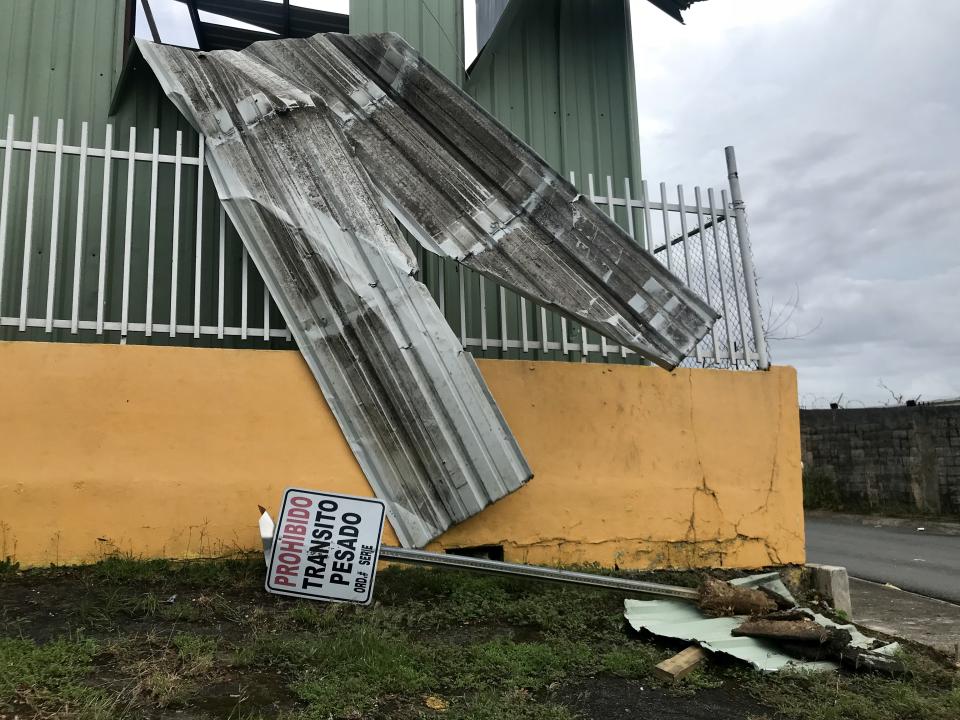
“I started tearing up when we were flying over the island,” she admitted, remarking on the splintered power poles, collapsed billboards, and blown out windows that rolled by like the frames of a disaster reel. “This is my home.”
Megan, who is 30, spent the first 15 years of her life in Bayamón before joining her mother and older brother in New York City, where they’d moved one year earlier.
New York is where her parents were both living when they met. After they married, in the early 1970s, they moved to the house in Bayamón first purchased in 1959 by Jesse’s mother, Mercedes Mercado. There, they raised five children, the youngest of whom was Megan.
Eventually all of the Vazquez children migrated to the States, leaving only their father and grandmother, affectionately known as “Nana,” to occupy the family house in Bayamón.
Located about 20 miles inland of San Juan, in Puerto Rico’s northern coastal valley, Bayamón looks as American as any part of the Midwest. Three-lane highways are flanked by shopping malls and big-box stores like Walmart, K-Mart, and Costco — two Costcos, in fact. Chain restaurants like Outback Steakhouse, Chili’s, and the biggest Burger King I’ve ever seen were open for business, all powered by large generators.

“This all used to be green,” Megan told me, gazing out the window in awe at the exposed hills of her hometown, dotted with houses but bare of the trees that once covered them. “I never knew Bayamón was so hilly.”
The Vazquez family house on Calle Alameda is a single-story, reinforced concrete structure surrounded by a white, wrought iron fence, similar to the ones that adorn the other houses on this residential street. Across from the house, Megan’s old elementary school is dark and dormant, a victim of the debilitating debt crisis. Puerto Rico reportedly shuttered 150 schools between 2010 and 2015 due to the financial disaster, and earlier this year, government officials announced plans to close 184 more.
As we drove around Bayamón that first day, Jesse pointed to a number of crumbling buildings and dilapidated houses that looked as if they had been decrepit since long before the recent natural disaster. “It’s hard to tell with some of these houses whether the destruction was caused by the hurricane or the financial crisis,” he said.

Jesse Vazquez talks like a New Yorker. Having spent a good portion of his formative years living on Manhattan’s Lower East Side, the 69-year-old speaks quickly and excitedly, seamlessly switching between English and Spanish midconversation — and even midsentence — peppering his requests or directives with the affectionate “mama” or “papi.”
Without electricity or a generator to power air conditioning or even a fan, Jesse had spent many restless nights shifting from the front porch to the front seat of his car, where he would listen to the radio while blasting the air conditioning. Without running water in the house, he’d been showering in the backyard with a hose that he attached to a rain collection barrel on the roof. He used the inverter from his car to charge his phone and even power the television for a few hours until the inverter overheated and the car battery died.
It wasn’t until Megan and Oscar arrived, with a generator in tow, that Jesse finally got his first full night’s sleep since the hurricane.
Like many Puerto Ricans, who have served in every war the U.S. has been involved in since World War I, Jesse is a military veteran. He and his brother were both drafted into the Army during Vietnam, but Jesse was discharged after boot camp owing to a heart condition. His brother, however, fought in Vietnam, and died about 10 years ago from hepatitis C contracted during his military service.
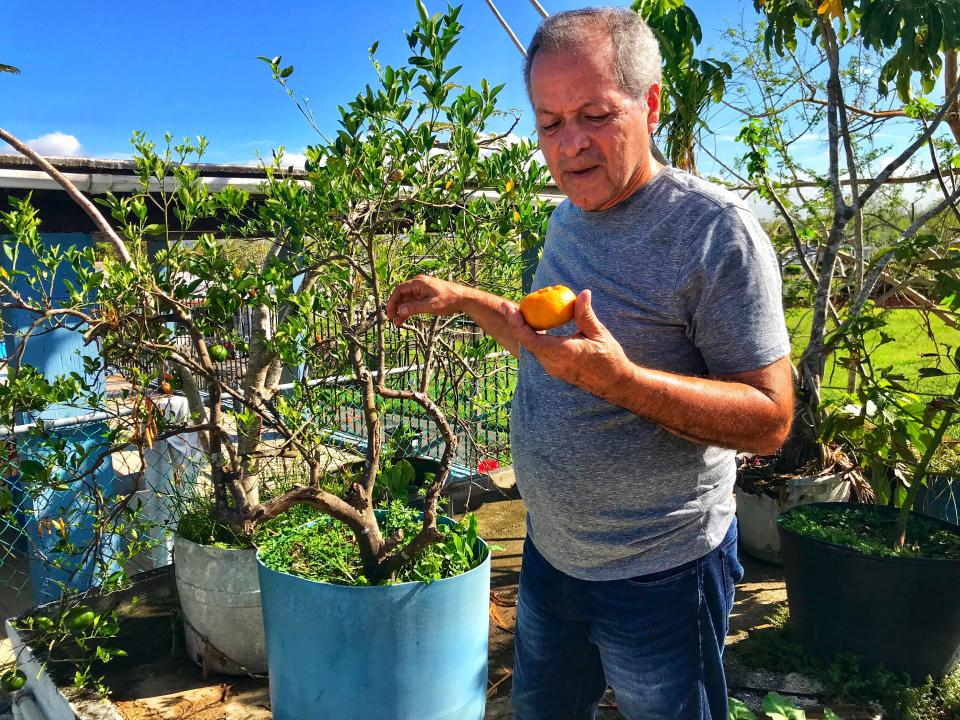
Jesse wanted us to see the long lines and limitations that had become the new way of life in Puerto Rico. Though the gas shortages that plagued the island immediately after the hurricane had mostly been remedied, even well-stocked supermarkets were rationing certain food items and all had imposed limits on how many cases of water each family could purchase at one time (usually one). Even then, most stores would run out of water by midday, forcing us to wait on the blistering pavement of several different parking lots before successfully restocking our supply. Ice, perhaps the most elusive commodity on the island, was always long gone by the time we reached the front of any line.
“We’ve gone back to being hunters and gatherers,” Jesse told me. Fortunately, neighbors were helping one another and making this exhausting new lifestyle slightly easier.
The woman who lives directly behind Jesse and Mercedes cleans a house in an upscale residential area that was one of the first to have its water restored. She brings buckets home from work to share with Jesse, which he uses to supplement the rain in his rooftop cistern. In return, Jesse picks up extra cases of bottled water and whatever supplies he can for her. Down the street, longtime neighbor Adolfus Treviño runs extension cords from the generator in his backyard to the house next door and another across the street.

Maria had also forced Jesse, a lifelong night owl, to become a morning person. Even though the island-wide curfew had been extended to midnight, in the absence of streetlights or even a glow from people’s houses or shops, most of the island fell under an impenetrable cloak of darkness by 7 o’clock each night.
By far the best equipped to handle the current lack of accommodations was Jesse’s mother, Mercedes, who only expressed mild distress over the lack of water with which to wash her clothes and dishes.
The 89-year-old matriarch of the Vazquez family was part of a generation of Puerto Rican women who moved to the United States in the 1950s, New York in particular, to work as seamstresses. Decades later, Mercedes’ sewing machine is still in use. She makes most of her own clothes and her house is decorated with various homemade pillows and cushions. Unlike her Spanglish-speaking son and grandchildren, Mercedes speaks almost exclusively in Spanish — though she knows more English than she lets on.
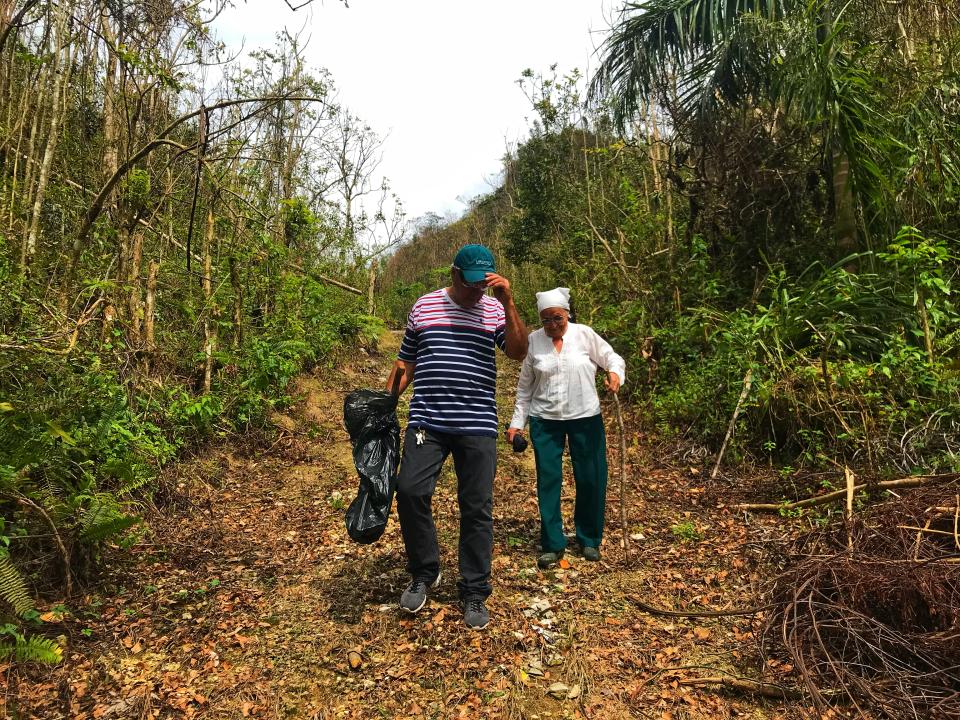
Always the first to rise at around 6 a.m. each morning, she would enjoy breakfast alone while reading passages from her Bible at the kitchen table before going into the backyard to pick fresh peppers, lemons and tangerines from her garden.
Over the next few days, we ventured out of Bayamón to check in on various family members and friends in other parts of the island. We went to Arecibo to visit Mercedes’ sister, and on the way, we stopped by Ramona and Santos Lopez Caraballo, the grandparents of Megan’s boyfriend, Eddie. The couple had been without cell service or any other mode of communication for a full 15 days after the hurricane. Santos, also an Army veteran, told us that his wife Ramona suffers from Alzheimer’s disease and he was beginning to worry about whether they’d be able to make it to her next doctor’s appointment. Pessimistic about the pace of the hurricane recovery effort, Santos was eager to leave the island, hoping to get a letter from Ramona’s doctor so she could seek treatment in New York instead. They told us that they had not seen any federal or local government aid workers — and had no idea where to find them.
“I thought I’d see more people but haven’t seen nobody,” Santos said. “Even the garbage, no one came for two or three weeks.”
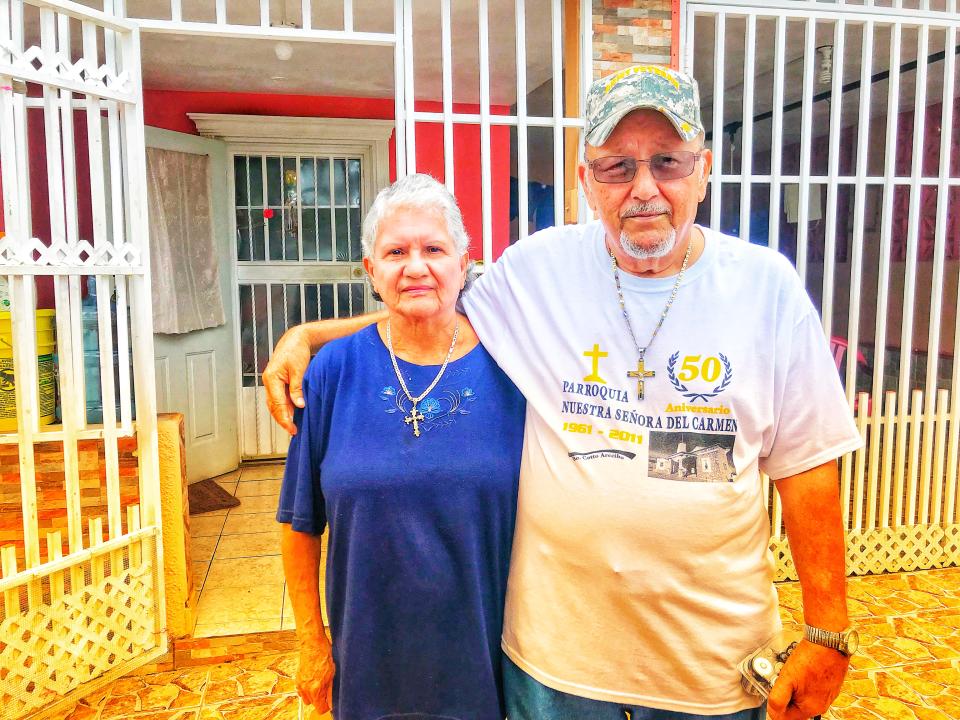
We drove into the mountains and passed families collecting water and bathing in streams along the way. We swerved to avoid downed power lines and uprooted trees that blocked the steep, treacherous roads to Utuado and Ciales, where we visited an elderly couple from whom Jesse receives an alternative treatment for his heart condition. Their house, isolated and completely cut off from communication, sat in the direct path of a potential mudslide.
We waded through sheets of rain and watched water splash above the tires of the cars in front of us as flash-flood warnings blared over the radio. On the highway near San Juan, we passed a billboard advising people to visit a website where the Puerto Rican government has been posting updates on the progress of the recovery effort, and we wondered how, without electricity, internet or decent cell service, most Puerto Ricans would be able to access this important information.

Back at the Vazquez house, we celebrated the return of running water, only to lament its disappearance 24 hours later. Megan and I stood outside in the rain and rinsed our hair in the water that flowed alongside the curb.
We discussed President Trump and whether the speed and scope of the federal government’s response to Puerto Rico had more to do with the island’s lack of the political clout that comes with statehood, than with the current administration.
“I think that if [Trump] didn’t exist it would be the same,” Jesse said of the federal relief effort. “I really do believe that.”
Megan marveled at how many people on the mainland don’t even realize that Puerto Rico is part of the United States, or that its more than 3.4 million residents are American citizens.
“There’s still a divide between Puerto Ricans and the United States, and it’s on the U.S.’s part,” she said when I confessed that, at least in my own 12 years of public schooling, I could not recall learning anything about the island or its history, other than the fact that it was a U.S. territory.
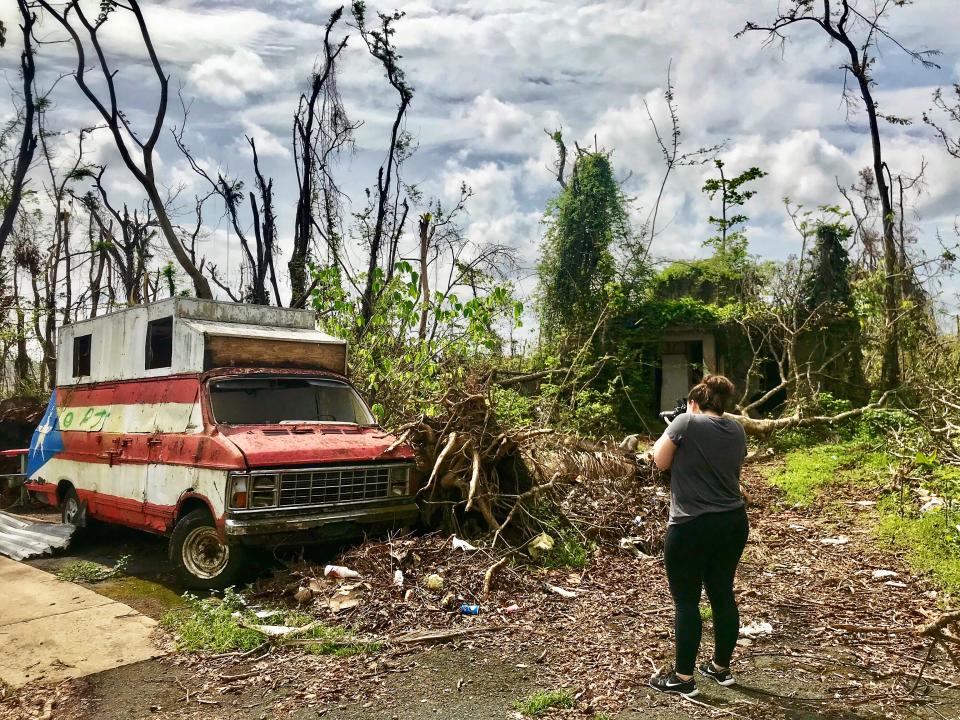
With all of her family members accounted for, Mercedes was determined to check on her most prized possession: approximately 20 acres of land in Hatillo, on the northern coast of Puerto Rico. Mercedes purchased the property in 1976 and, over the years, converted it to a beloved family farm — a place for camping trips and cookouts, where avocados, bananas and a variety of other fruits and vegetables could be picked from the trees and brought home to eat or share with neighbors.
Megan worried about the stability of the road that leads to the property, which was already in bad shape before the storm, but she knew her grandmother was eager to visit the farm and assess the damage from the hurricane. Sure enough, not long after we arrived in Bayamón, Mercedes asked, “Cuando vamos a la finca?” — “When are we going to the farm?”
To Megan’s consternation, her grandmother persisted, and we all piled into the car for the journey to Hatillo. Along the highway, we spotted clusters of cars pulled over on the shoulder every few miles, a sign that we were passing through a patch of decent cell service. Our phones buzzed with belated text messages.
Cars whizzed past an empty tollbooth. We passed the entrance to an outlet mall in Barceloneta and looked agog at the giant IHOP sign laying flat on the ground, its metal pole having buckled under the pressure of Maria’s 155-mile-per-hour winds.
A large, wooden utility pole blocked the entrance to the road to Hatillo, forcing us to detour. The closer we got to the farm, the narrower and more rugged the road became, until finally we reached what appeared to be a dead end. Really, it was just the beginning of the path to the farm.

Careful not to run over the chickens casually crossing the pavement, we parked in front of a small, orange house with white columns and at least four cats milling around outside. A frail woman with orange hair and a misleading scowl on her face emerged onto the porch, and Mercedes exclaimed, “Callita!”
Everista Alicea Gonzalez, nicknamed “Callita,” has lived in this house on the edge of the Vazquez family farm her entire life. She has endured hurricanes before but, she said, this latest “tormenta,” an acutely accurate Spanish word for “storm,” was by far the worst.
“They say the name was ‘Maria,’ but it was not from Maria,” she said, referring to the Virgin Mary.
Alicea lives alone with her cats and a dog, who sat silently in a crate on the porch. In the distance, we could make out the blue walls of the house where her parents lived before they passed away. The roof had been swept away by the storm and the inside was likely now soaked by rain.
“No one has come here,” Alicea said, when asked whether she’d seen anyone from FEMA, the National Guard, or any other type of relief. “Just a neighbor, he brought me a bit of water the first day. But anyone from outside? No, no one has come.”
Instead, Alicea has descended the hill beside her house a few times by foot to try to replenish her food supply herself, and she’s encountered a few obstacles. She receives food stamps but, without power, most supermarkets didn’t have the system to process them. She went to the bank to withdraw cash but could only get $200.
Along with depriving Alicea of running water and electricity, Maria’s torment has left Alicea completely without communication. She spoke to her son, who lives on another part of the island, once before the storm but has not been able to talk to him since. We offered to let her use our satellite phone to call him but she didn’t know the number. It’s saved in her cell phone, which is dead.
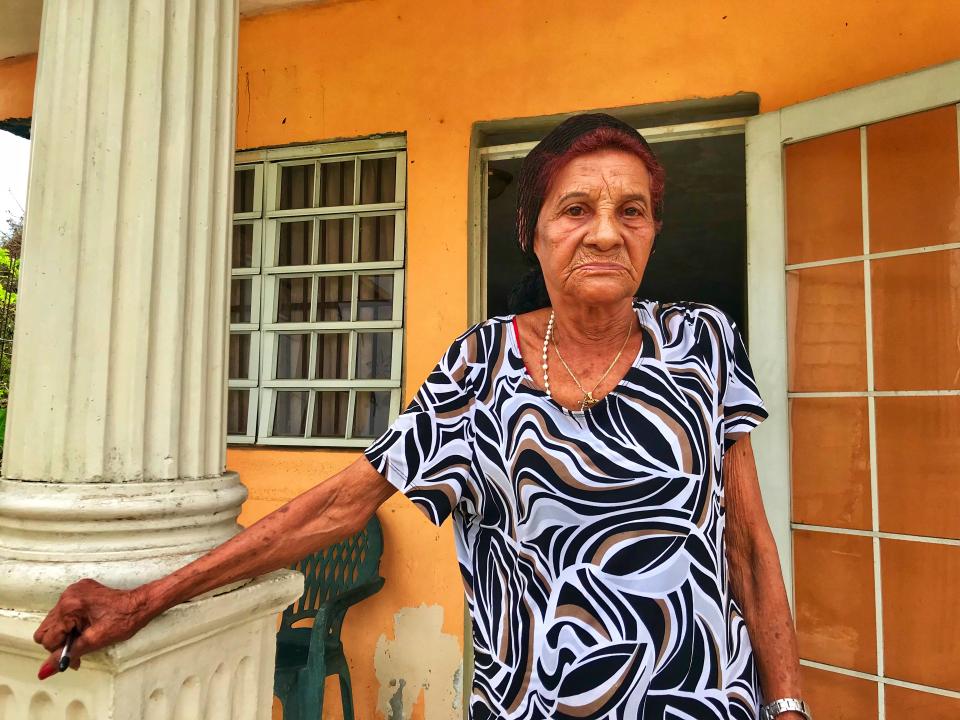
Without television, phone, or radio, Alicea’s life in this remote, rural corner of Puerto Rico has become even more solitary. During the day, she said she cleans the house and goes to collect water to drink from a well down the hill.
“To bath, I wash with rainwater under the sky,” she said.
She thinks it might be a year before things are back to normal. And yet, asked whether she felt angry or frustrated, Alicea replied, “No, no. I feel sad.”
Though her concrete house survived without any real damage, “the nature outside” was not so lucky.
“It blew away the whole thing,” she said.
We left Alicea with a couple of extra flashlights, cans of food, and bottles of water and continued toward our destination — now on foot.
Dark storm clouds loomed overhead as Jesse and Oscar led the way, each armed with a machete to hack away at the limbs of fallen trees that blocked our path. “Oh man,” I heard Jesse say from a few feet ahead. “It’s not only that tree but that other tree and that other tree and that other tree.”

What Megan had described as a formerly lush hillside now looked like the scene of an arboreal massacre. The skeletal trunks of avocado trees hung upside down by their roots, tangled with giant stalks of bamboo bent in half like broken straws. Beneath our feet lay the flattened corpses of banana trees, their wing-like palms brown and muddied.
Most of these trees had been alive and well before Maria tore through here, taking them before their time, and their thick branches weren’t yet easy to break. The hurricane’s forceful winds stripped many of them, but leaves still clung to others, creating a web of branches through which we had to pass in order to reach the farm.
“We should’ve brought the chainsaw,” said Jesse. After a few whacks at one particularly resilient branch, the wooden handle of Oscar’s machete began to separate from the blade.
Megan stopped for a drink of water and asked her grandmother, in Spanish, “What do you think about this? What are we going to do?”
“We have to clean,” Mercedes replied, leaning against a walking stick in one hand while swinging a machete of her own with the other. “That will be done by hand, mami.”
For Mercedes, the farm is sacred ground, a place where she can “communicate with nature.” Even in this unrecognizable state, from the moment we step onto her precious property she is brimming with delight. She takes her time, letting everyone else continue ahead of her as she takes everything in, the white handkerchief tied around her head always visible against the brown and green backdrop of the dismembered forest.

She laughs as she assessed the damage and insists that while “Maria has made a disaster,” she knows that “in nature, everything will come back again.”
“Look!” she says, with childlike excitement. “Maria left me a little flower.”
Using both the walking stick and her machete for balance, Mercedes climbs toward a delicate white blossom peeking out from between a pile of lifeless leaves, holds it to her nose and inhales deeply. A serene smile washes over her tanned, lined face.
“Lirios,” she says. Lily. “Take it.”
Commonly used at funerals, white lilies are considered by some to signify death and rebirth. They are also known as Madonna Lilies, a symbol of purity used by many Christian denominations to represent the Virgin Mary or, in Spanish, Maria.
We all finally make our way under the wood paneled roof of the concrete gazebo just in time for the menacing sky to release a brief but heavy rain. Jesse has wiped off the plastic chairs that were flung into the brush during the hurricane and everyone takes a seat except for Mercedes, who is pulling a small plant out of a brown shopping bag that she brought with her from Bayamón.
It’s a caimito plant, a tropical fruit that shares its name with a barrio in San Juan where Mercedes’ family had a farm when she was a young girl.
“I have a lot of memories from Caimito. My father died there,” she says, brushing the remnants of dead plants aside to make room for new life. “I brought this caimito fruit to grow here, to remember Caimito.”
There is more work to be done here than we can accomplish in one day, but Mercedes is hardly discouraged. On the hike back down to the car she tells me, “I know that after the storm, comes the calm.”
Outside the airport a few days later, I bid farewell to the Vazquezes as others around me say more tearful goodbyes to their own families. Inside, the bright, heavily air conditioned terminal we’d arrived at one week earlier has become a dimly lit, chaotic sauna. A single fan provides little relief to the hundreds of parents, grandparents, little kids, and several dogs who fill the sweltering airport, all of whom are desperately leaving the island in search of refuge in the States. Two young boys decked out in Chicago Bulls paraphernalia shuffle ahead of me in line for security. To my right a middle-aged man wears a T-shirt with the image of a bald eagle beneath the words “Freedom isn’t free.”
I finally reach the security checkpoint after at least an hour and notice a piece of computer paper posted to one of the inoperable automatic doors. It is printed with bold red letters that read, in English, “Please Be Patient Currently Running on Generator Power.”

Read more from Yahoo News:





